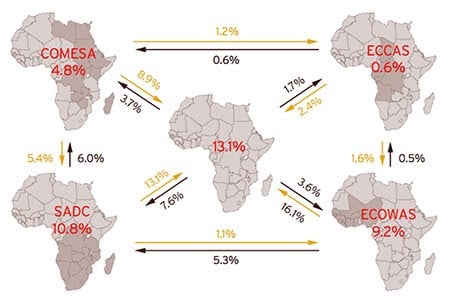Notes on Economic Geography of Regional Integration (Gill & Deichmann)
BONUS LINK: My entire (so far) grad school notes collection can be found here.
"To Regionally integrate or not to regionally integrate"
Overall Summary
The authors argue
that traditional assessment is debating the wrong issue. They are typically arguing which is
better—global trade agreements or more focused regional approaches.
2 False
assumptions:
- Debate also
assumes regional integration is just about preferential trade access
- It’s not an “either or”
choice—regional integration can act as a stepping stone allowing small states
to scale up their supply capacity—eventually giving them access to world
markets.
- Developing
countries must not only encourage transformation across its industries and
services but also spatially within its borders—this means balanced growth in
density, distance and division. This
spatial distribution can help alleviate the fates of the “bottom billion” that
are still accumulating to urban centers that don’t have access to the global
markets—exacerbating their situation in ever growing slums. This requires thoughtful and intentional
government planning at the 3 spatial levels:
Connective Infrastructure
Blind Institutions
Targeted Incentives
What countries benefit most?
They are quick to
point out that ALL countries can benefit from this type of
integration—however—small countries located far from world markets can
certainly benefit most. This usually means countries in Africa and
Central Asia.
Why?
Regional integration allows: boosted supply capacity by
providing regional public goods and maximizing specialization
3 key principles:
Start Small, Think Global, Compensate the least fortunate
Start Small—clearly defined narrow areas of
cooperation—EU started out as agreement by six countries on coal and stell
Think Global—No Islands! Access to global markets is the key! Small poor landlocked countries MUST have
regional integration to LEAPFROG them into the global scene
Compensate the Least Fortunate—development means
specialization and drives population to those centers. This must be balanced with remittances as
well as explicit compensation for infrastructure and social services (to
promote even spatial growth). Also
requires local effort and government policies like revenue sharing to
compensate the landlocked countries.
This requires a tailored approach (all to overcome thick
economic borders):
1. Regions close to major world markets
Common
institutions key (thin economic borders)
2. Regions with big economies far from world markets
Regional infrastructure to
increase home market which also increases access for small countries (connect)
3. Regions with small economies far from world markets
Bottom
billion countries. Need ALL THREE
I’s: Institutions, Infrastructure and
Incentives (increased support for infrastructure development for instance).
SUMMARY:
-->
SUMMARY:
The authors basic argument is that most economists have been
asking the wrong questions and making the wrong assumptions. This boils down to two common false
assumptions:
1. Regional integration is just about preferential trade
access
2. Regional
integration and global trade agreements are an “either” “or” proposition.
They argue that these assumptions ignore the relationship
between the two methods and that the approach needs to be tailored to each
nations geography (both physical and economic).
To that end they argue for three combined approaches:
1. Institutions blind
to the physical borders
2. Connective regional infrastructure to enable trade
3. Incentives for the
more isolated power countries.
Using these approaches can boost a small nation’s supply
capacity and allow for the maximization of specialization.
The authors
are quick to point out that while small geographically isolated underdeveloped
countries are the ones most likely to benefit from this approach (most African
and central Asian nations), ALL nations can benefit. The key for the small nations disconnected
from the global market is spatially purposeful development—meaning spatial
balance for density, distance and division.
The common propensity is for the population of developing countries to
migrate to the urban centers. But when
these urban centers are isolated without access to the global markets this just
creates slums. This is one of the
central problems described by Collier in Bottom
Billion. This phenomenon follows
Kuznet’s widely accepted hypothesis that describes how poor localized
agricultural economies experience a rapidly widening income gap when
urbanization occurs.
Regional integration then offers these nations a springboard
by which they can develop evenly and gain access to global markets
eventually.
The authors
advocate three central principles. The
first is to start small. They give the example of the European Union which
originally began as a trade agreement between three nations regarding coal and
mining. A narrow focus allows countries
to develop evenly and to focus on full economic integration. The next principle to think globally. The end result is never solely regional
integration but is instead using that connective infrastructure to leapfrog a
small cutoff country into the global economy.
The last principle is to compensate the poor or disadvantaged. This means that a government must be
purposeful in balancing urban development by raising the baseline of the physical
infrastructure in the nation.
Practically this means paving roads and ensuring an expansion of
baseline social services. This can also
take place in the form of remittances sent back home to the countryside which
when used well can spur development there.
Overall,
the authors stress the need to overcome the thick economic borders of many
states. They describe how large nations
with access to the global economy benefit from integrated institutions. They add that large nations far from the
global market can expand their reach through a connective regional infrastructure. Lastly they add that the small nations far
from the global market can benefit a combination of institutions,
infrastructure and incentives.
LINK:
http://www.imf.org/external/pubs/ft/fandd/2008/12/deichmann.htm

No comments:
Post a Comment